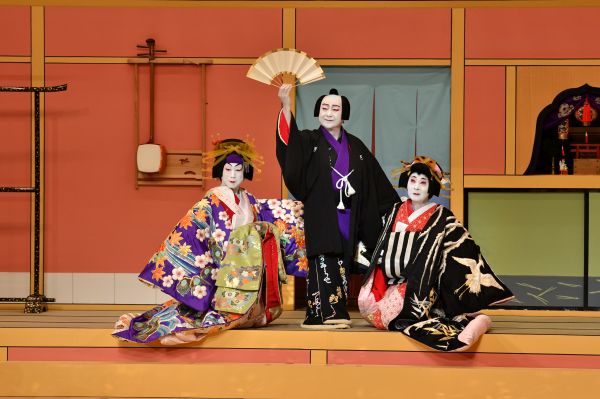
This essay is going to focus on the beauty and sensory experience of Kabuki that is presented to the audience members through the stage machinery, props, music, performance style, and appearance of the actors that is described in Kabuki Drama, written by Miyake.
Kabuki is a popular form of Japanese drama with dancing, music, and acting and means the art of songs and dance. These plays consist of various stories about historical events, love stories, moral conflicts, and warm-hearted dramas. Common themes to take from the drama are loyalty, love, honor, and revenge. There are three kinds of Kabuki plays: Sewamono, Jidaimono, and Shosagoto. Sewamono plays are very classic and one of the more realistic plays with a common theme of family dramas and love suicides. Jidaimono plays are based on major historical events in Japanese history; however, during the Edo period, there were strict laws forbidding the plays to portray the shogun or any historical event in any bad light. Shosagoto plays are dance dramas where dance movements were used to convey the plot, emotion, and character traits. Portraying these stories in this fashion is a way to connect to the Japanese culture that the public can enjoy and learn from. A typical Kabuki drama lasts for around four to five hours with breaks in between scenes. Kabuki dramas are known for their beauty and extravagance. “It is to be understood as an art intended to appeal to the senses and the perception, an art to feast the eye rather than to satisfy the intellect.” (Miyake, 11). There are three popular types of theatre: Noh, Kabuki, and Bunraku. Kabuki stands out among these three because of its stylized manner. When producing a drama, reality is not taken into account, as every aspect, including the appearance of the actors, scenes, music, and gestures, is very grandiose. When watching a Kabuki drama, one must appreciate its artistic value and should expect “a trip to a land of dreams—to a land of poetic vision.” (Miyake, 10).
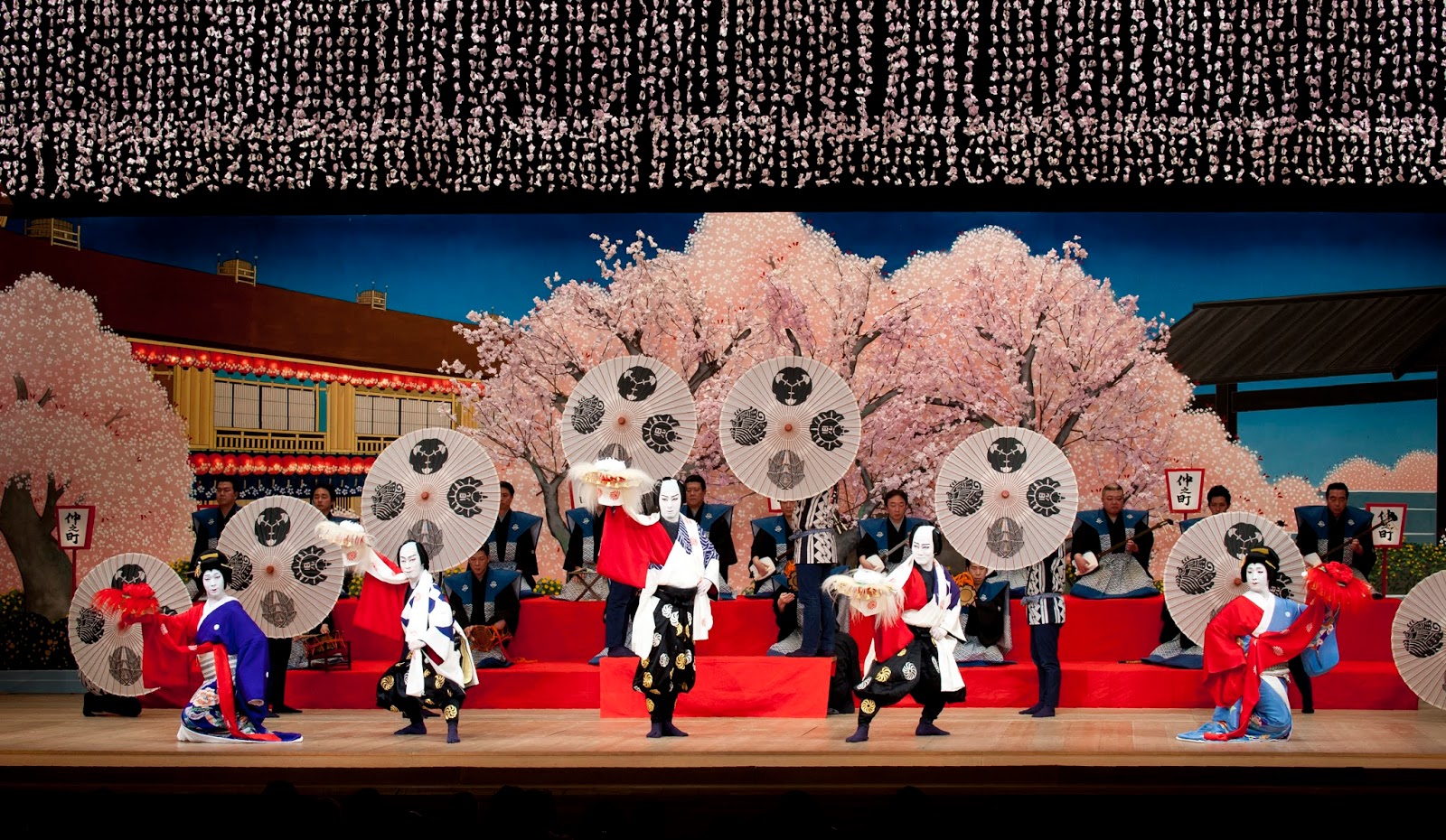
The art of Kabuki was created by an all-female group. In the early 1600s, Okuni, a Shinto princess from the Izumo province, formed an all-female group consisting primarily of prostitutes and misfits who were taught to act, dance, and sing. However, in 1629, females were prohibited from performing Kabuki dramas because their performances were too vulgar. The government didn’t want men to fight over the actresses as they would typically offer their services to men after the play is over. Young men were then dressed up in female costumes as a replacement for the females. In 1652, the young men were also prohibited from performing as they were considered attractive and suitable for prostitution. The performers needed to be more mature, so the government felt that adult men were the best fit to perform in Kabuki plays. During the Edo period, a period of traditional Japan with a stable economy, politics, and a strict social order, the Kabuki theatre evolved from the traditional Noh theatre and became more elaborate with the addition of curtains and more complex stage machinery like revolving stages. During the Golden Period in the 18th century, Kabuki became an established art form with complex stage sets, performance and musical styles, and appearances. The repertoire of Kabuki also expanded to include more variety of plays like ghost plays. Kabuki remained popular throughout history because it attracted commoners as the audience members, where they were allowed to wear and eat whatever they wanted as well as make noises during the performance. Noh was appealing to the upper class, while Kabuki was appealing to the general public.
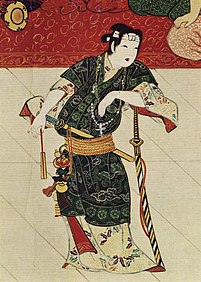
Due to the all-male cast, the best looking actors play the roles of the female characters. This is called an onnagata where they were trained from a young age. Before the Meiji Restoration in 1868, the onnagata performers were allowed to dress in female costumes off stage as well to get to know their character even better. Onnagatas train so much that they may know a woman better than she knows herself. “In fact, the onnagata has made it possible for the Kabuki play to present a type of feminine beauty impossible in ordinary conditions.” (Miyake, 21). The onnagata characters add to the beauty of Kabuki.

Kabuki consists of four artistic qualities to help create this extravagant performance. One element that has evolved throughout history is the stage decorations and machinery. These stage decorations help create a surprise element throughout the play which makes it seem more magical, adding to the aesthetic of the Kabuki plays. The curtain or a Maku is important because the patterns on the curtain complement the spirit of Kabuki and is the first thing the audience sees. A typical curtain is striped with green, red-brown, and black lines. There are other curtains like a black curtain to signify invisibility and a blue curtain to signify heaven. Another stage machinery is the Hanamichi or the flower passage that starts from the back of the audience to the main stage. Since the platform is in between the audience, it creates a closer contact with the audience that adds to the sensory experience. The Hanamichi is typically used for climactic scenes like the entrance or exit of an important character and emotional scenes. The revolving stage or the Mawari Butai rapidly moves the scenes on the set to reduce the intervals between each scene. This rapid change of the scenes creates a sensory illusion. The Suppon, also known as the snapping turtle, is a platform that rises from below the stage or lowers the platform from above the stage. This can make the actor appear or disappear from the stage, creating an unexpected illusion and adding to the esthetic of Kabuki. Another element is the stage props. Typically, stage props are fans, umbrellas, insects, animals, swords, and flowing water. The art of Kabuki is to make something unreal look real. For example, the flowing water is made out of rolls of linen. The insects would be dangled from sticks. In the Japanese culture, fans were once thought to keep away evil and were used during religious ceremonies. Fans are prominent in Kabuki plays because they are symbolic of wind, rain, and waves, and many other objects.

Another essential element to Kabuki is the performance techniques. The Mie pose is one of the most important and well-liked performance techniques. Mie is a very powerful and dramatic pose with a caricaturesque facial expression and crossed eyes that presents the character’s emotions. When performing this technique, the actor freezes for a moment to bring significance to this critical part of the play. “The pose of mie may seem unnatural, but this is the Kabuki way of emphasizing the senses of excitement, sorrow, and emotion.” (Miyake, 50). The audience would typically clap during the pose. Roppo is a very exaggerated manner of walking or running on the Hanamichi platform typically away from the main stage. It includes large, stylized arm and leg movements that are used to indicate the exit of an important character. Tachimawari is a battle scene, typically more realistic, with sword fights between Samurais including martial arts movements and intense music in the background. Michiyuki means going on a journey. These are travel dances where tragic lovers go on a journey to find their destiny, where they will carry out their suicide pact. Seppuku is a ritual suicide scene, where a Samuari would willingly give up his life for his country.
The music is another element of Kabuki. The shamisen is a three-stringed Japanese instrument with a long and thin neck. It is the leading instrument in Kabuki music. There are musicians on-stage and off-stage. The musicians off-stage would typically play the background music or sound effects and the musicians on stage would perform more scenic music. Nagauta means long song and is a type of lyrical music that is accompanied by singers, multiple shamisen musicians, and a flutist. Debayasi is a visible orchestra that is performed during emotional scenes with the accompaniment of shamisen musicians. The Nagauta and Debayasi music is on-stage. Geza musicians are hidden behind a bamboo curtain on the side of the stage, where the musicians would create sound effects that imitates water, rain, bells, storms, etc. to enhance the sensational experience and “to add to the reality and impressiveness of the performance on the stage.” (Miyake, 28). The Ki is two wooden clappers that were played together to signal the beginning and end of the play. The Tsuke wooden clappers helped to emphasize the dramatic scenes and poses like the Mie pose. The Ki and Tsuke wooden clappers and the Geza are off-stage music.

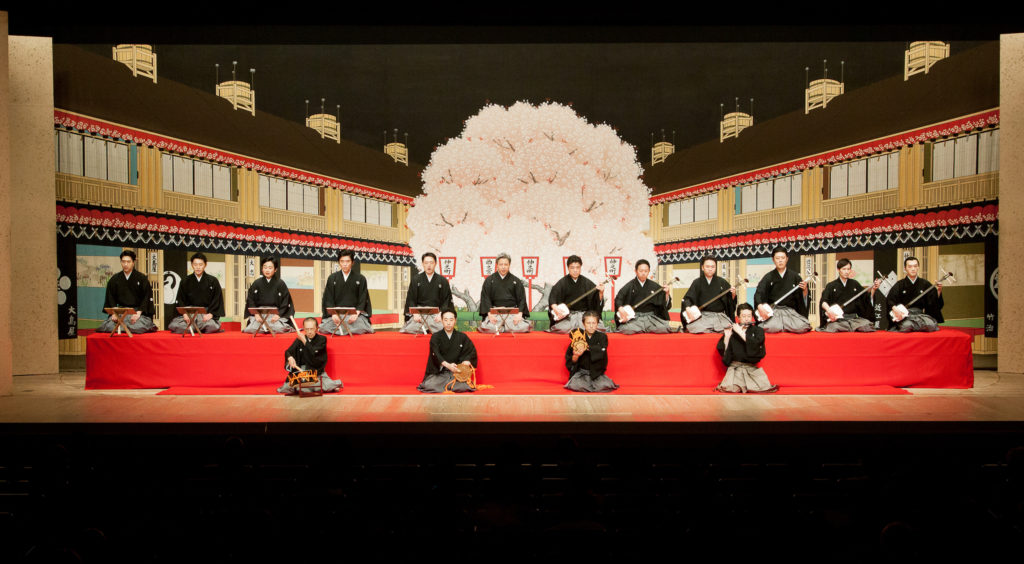
The appearance of the actors is used to heighten and enhance the performance. The costumes incorporate bright colors and silver and gold threads woven throughout them. Onnagatas typically wear elaborate kimonos and gowns, and male actors typically wear wide, skirt-like trousers with stiff shoulder extensions. All costumes include a wig. “The unwieldy wig becomes but an element that goes towards the building up of beauty and character harmony.” (Miyake, 21). Actors may find it challenging moving around in their costumes and wigs as they are heavy. The next aspect is makeup. Kesho is makeup that is based on the actor’s character traits. Kumadori is a style of makeup that is worn on-stage by the actors. Since the actors do not wear masks on stage, there are mask-like makeup styles. The actors would first apply a thick coat of white paint to make their faces more visible. Then, the actors would apply colored lines on their faces. The color of the makeup helps to highlight the actor’s facial expressions and emotions. The color red means good and expresses anger, and the color blue is bad and expresses fear or jealousy.
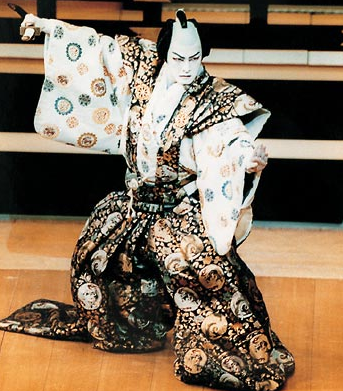

The engagement of the audience is important as it helps to maintain the popularity of the Kabuki plays. The goal of the actors is to make their performance as appealing and entertaining to the audience by perfecting their facial expressions and acting to enhance the aesthetic of Kabuki. It takes a lot of preparation and training for the actors to perfect their characters. The audience members like to shout during a performance for their favorite actor or applaud loudly during an exciting scene. They would also bring food to Kabuki performances and socialize with their friends.
Overall, Kabuki has this extravagance to it that makes it so unique and rich. When watching a Kabuki play, one must appreciate the beauty of the performances. The artistic qualities of Kabuki like the stage machinery and props, performance techniques, music, and appearance of the actors enhances the aesthetic and sensory experience.
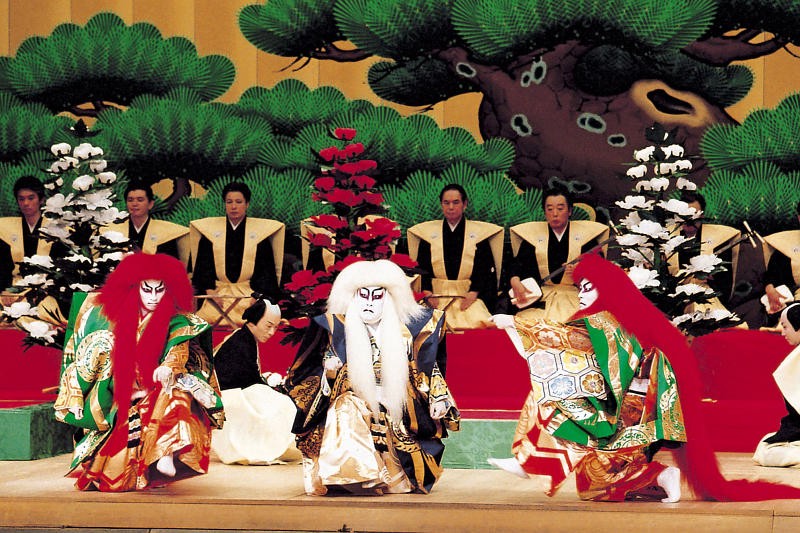
Bibliography:
Miyake Shūtarō. Kabuki Drama. Routledge, 2016.
Written by Ishani Dave
Categories
Calendar
| M | T | W | T | F | S | S |
|---|---|---|---|---|---|---|
| 1 | ||||||
| 2 | 3 | 4 | 5 | 6 | 7 | 8 |
| 9 | 10 | 11 | 12 | 13 | 14 | 15 |
| 16 | 17 | 18 | 19 | 20 | 21 | 22 |
| 23 | 24 | 25 | 26 | 27 | 28 | 29 |
| 30 | ||||||